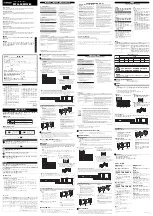
12
4.5 Relay functionality
Relay
Relay functionality
1
For future use
2
Self test relay
: On start up this relay is latched by pressing the button on the front
panel of the receiver unit.
If the self test routine of the microprocessor detects a malfunction at any time this
relay will be reset, completely isolating the unit from the vehicle power supply. The
normal start up procedure can be used to restart.
3
It can be used either to drive a warning light, whenever the winches pull in cable, or to
control an hydraulic pump whenever the hydraulic system is used. The function of this
relay is controlled by DIL switch no.5 (see section 4.6 for details)
4
This relay is in series with the self test relay and switches the control relay bus
voltage. R4 can be latched on start up, after the self test funcion is complete, by
pressing the
Stop
button while holding the
Gas+
button pressed (the normal methode
of switching into active mode)
R4 is alo used to switch between standby and active mode: The
Stop
button is used
to enter Standby mode, isolating the control relays, and the same sequence as above
to enter the active mode.
The output of this relay is also available externally on the 13pin plug.
5
This relay switches if the
Hupe
and
K. Lösen I
buttons are both pressed on the hand-
held transmitter. This relay can be used to drive an
engine start
mechanism.
6
This relay can be used to initiate an external
emergency call
. The function is
controlled by DIL switch no. 3 (see section 4.6 for details)
7
This relay switches if the
Hupe
and
K. Lösen II
buttons are both pressed on the hand-
held transmitter. This relay can be used to drive an
engine stop
mechanism.
8
This relay switches when the
Hupe
button on the hand-held transmitter is pressed.
The output is normally open circuit and switches to the supply voltage of the vehicle
(12 or 24 V
DC
).
It is recommended that an external relay is installed to
drive the horn
, as the horn
may draw a large current. This would cause the polyswitch fuse to drop out, and as
described above this can eventually damage the output relay.
9
This relay is controlled by the
Ziehen I
button on the hand-held transmitter. It is used
to drive the
clutch on winch no.1
.
10
This relay drives an actuator to control the skidder´s accelerator mechanism in the
funktion
Gas-
. Its function is controlled by DIL switch no. 2 (see section 4.6 for details)
11
This relay is controlled by the
Ziehen II
button on the hand-held transmitter. It is used
to drive the
clutch on winch no.2
.
12
This relay drives an actuator to control the skidder´s accelerator mechanism in the
funktion
Gas+
.Its function is controlled by DIL switch no. 2 (see section 4.6 for details)
13
This relay is controlled by the
Lösen I
button on the hand-held transmitter. It
releases
the brake on winch No.1
. It is controlled by DIL no. 4 (see section 4.6 for details).
14
This relay is controlled by the
Lösen II
button on the hand-held transmitter.It
releases
the brake on winch No.2
. It is controlled by DIL no. 4 (see section 4.6 for details).
15
For future use
16
Switch-over 1./2. gear of the winch (optional)
Summary of Contents for HM 2225
Page 17: ...17 9 View on the pc board of the receiver ...
Page 18: ...18 10 Block diagram of the receiver ...
Page 20: ...20 ...






































